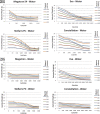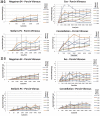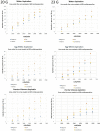Comparison of modern high-speed vitrectomy systems and the advantages of using dual-bladed probes
- PMID: 33468260
- PMCID: PMC7814550
- DOI: 10.1186/s40942-020-00277-2
Comparison of modern high-speed vitrectomy systems and the advantages of using dual-bladed probes
Abstract
Purpose: This study analyzes the efficiency of different vitrectomy systems and compares single with double-bladed cutters.
Methods: The systems EVA™ (DORC), Constellation® Vision System (ALCON), megaTRON S4HPS (Geuder) and Stellaris® PC (Bausch and Lomb) were used. We chose 20G and 23G probes, since not all systems had switched to a smaller G at the time the study was conducted in 2016. Cut rates were varied in increments of 1000 cuts/min from 500 cpm to the system's maximum and vacuum pressures were varied in increments of 100 mmHg, from 100 to 600 mmHg up to the individual system's maximum. In this study water, egg white, Pluronic®-F127 gel and isolated porcine vitreous were used as models of human vitreous. The vitrectomy efficiency was calculated from the aspirated mass (g) within 30 s. The aperture of the different vitrectomy probes was filmed with a high-speed camera.
Results: The area under the curve analysis showed differences in efficiency between vitrectomy systems. For water, a reverse relationship between the aspirated mass and cut rate was shown. By contrast, for most systems aspirated egg white and porcine vitreous showed a non-linear increase or decrease for 4000 cpm and above. For all vitreous surrogates, EVA™'s double-bladed probe aspirated significantly (p < 0.001) more vitreous than its mono-bladed probe. Video recordings showed less vitreous traction for double- in contrast to single-bladed probes.
Conclusion: We can demonstrate differences in the efficiency of vitrectomy depending on the vitrectomy system used. Double-bladed probes were more efficient and probably safer than single-bladed probes.
Keywords: 20 gauge; 23 gauge; Vitrectomy; Vitreous; Vitreous model.
Conflict of interest statement
The authors declare that they have no competing interests.
Figures







Similar articles
-
In Vitro Comparison of Various High-Speed Vitrectomy Machines Using Dual Blade Cutters.Cureus. 2021 May 14;13(5):e15021. doi: 10.7759/cureus.15021. Cureus. 2021. PMID: 34136317 Free PMC article.
-
Vitreous flow rates through dual pneumatic cutters: effects of duty cycle and cut rate.Clin Ophthalmol. 2015 Feb 5;9:253-61. doi: 10.2147/OPTH.S71387. eCollection 2015. Clin Ophthalmol. 2015. PMID: 25709386 Free PMC article.
-
Experimental Assessment of the Performance of Dual Pneumatic Vitreous Cutters According to Gauge and Cut Rate.Korean J Ophthalmol. 2023 Aug;37(4):307-313. doi: 10.3341/kjo.2023.0045. Epub 2023 Jul 3. Korean J Ophthalmol. 2023. PMID: 37400083 Free PMC article.
-
Machines and Cutters: Stellaris PC.Dev Ophthalmol. 2014;54:8-16. doi: 10.1159/000360443. Epub 2014 Aug 26. Dev Ophthalmol. 2014. PMID: 25196746 Review.
-
Machines and cutters: Constellation®.Dev Ophthalmol. 2014;54:1-7. doi: 10.1159/000360442. Epub 2014 Aug 26. Dev Ophthalmol. 2014. PMID: 25196745 Review.
Cited by
-
Performance, safety and efficiency comparison between a 25G 20,000 and a 10,000 cuts per minute vitrectomy: a prospective randomized control study.Int J Retina Vitreous. 2025 Apr 14;11(1):45. doi: 10.1186/s40942-024-00613-w. Int J Retina Vitreous. 2025. PMID: 40229644 Free PMC article.
-
Human Vitreous Collagen Fragments Dimension As a Function of Vitrectomy Cut Rate.Transl Vis Sci Technol. 2022 Mar 2;11(3):29. doi: 10.1167/tvst.11.3.29. Transl Vis Sci Technol. 2022. PMID: 35333285 Free PMC article.
-
In Vitro Comparison of Various High-Speed Vitrectomy Machines Using Dual Blade Cutters.Cureus. 2021 May 14;13(5):e15021. doi: 10.7759/cureus.15021. Cureus. 2021. PMID: 34136317 Free PMC article.
References
Grants and funding
LinkOut - more resources
Full Text Sources
Other Literature Sources

